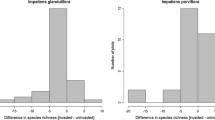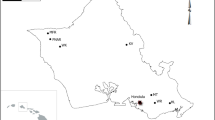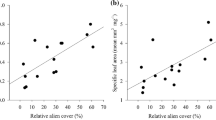Abstract
Community ecologists implicitly assume redundancy when they aggregate species into functional groups. But there have been remarkably few empirical efforts to investigate the accuracy of this concept in situ. The concept of redundancy could be roughly split into two components: the ecological redundancy (similar response to environmental variations involving similar ecological processes) and the functional redundancy (similar biological trait combinations shaping similar functional processes). Both types of redundancy are tested among the 3 invasive European Elodeas. In 11 sites and during two successive years 2004–2005, the cover growth rate of each Elodea species was monthly recorded. To test ecological redundancy, cover growth rates were related to a large suite of environmental variables. To test functional redundancy, 13 biological traits involved in competitive relationships were measured each month. Firstly, the redundancy hypothesis looks problematic for Elodea ernstiae. Indeed, the later possess numerous biological traits involved in light competition and niche overlap with the other Elodeas is very low. Secondly, ecological and functional redundancy can be successfully applied to Elodea canadensis and Elodea nuttallii. They share a large suite of biological traits leading to wide niche overlaps through the growing season. And the measured environmental variables do not differentially influence their growth rates, which are, in turn, controlled by a similar group of biological traits. In this way, the different invasiveness patterns of E. canadensis and E. nuttallii could be solely due to the ecological drift and their ecological dynamic could follow neutral rules.


Similar content being viewed by others
References
Agrawal AA (2001) Phenotypic plasticity in the interactions and evolution of species. Science 294:321–326
Barrat-Segretain MH (2005) Competition between invasive and indigenous species: impact of spatial pattern and developmental stage. Plant Ecol 180:153–160
Barrat-Segretain MH, Elger A, Sagnes P, Puijalon S (2002) Comparison of three life-history traits of invasive Elodea canadensis Michx. and Elodea nuttallii (Planch.) H. St. John. Aquat Bot 74:299–313
Blumenthal D (2005) Interrelated causes of plant invasion. Science 310:243–244
Callaway RM, Aschehoug ET (2000) Invasive plants versus their new and old neighbors: a mechanism for exotic invasion. Science 290:521–523
Davis MA, Grime JP, Thompson K (2000) Fluctuating resources in plant communities: a general theory of invasibility. J Ecol 88:528–534
DeWitt TJ, Sih A, Wilson DS (1998) Costs and limits of phenotypic plasticity. Trends Ecol Evol 13:77–81
Di Nino F (2002) Caractérisation morphogénétique des Elodées de Loraine et de la plaine d’Alsace—Mémoire du DEA en Toxicologie de l’Environnement. Université de Metz, Metz
Didham RK, Tylianakis JM, Hutchison MA, Ewers RM, Gemmell NJ (2005) Are invasive species the drivers of ecological change? Trends Ecol Evol 20:470–474
Gitay H, Wilson JB, Lee WG (1996) Species redundancy: a redundant concept? J Ecol 84:121–124
Greulich S, Trémolières M (2006) Present distribution of the genus Elodea in the Alsatian Upper Rhine floodplain (France) with a special focus on the expansion of Elodea nuttallii St. John during recent decades. Hydrobiologia 570:249–255
Gurevitch J, Padilla DK (2004) Are invasive species a major cause of extinctions? Trends Ecol Evol 19:470–474
Hérault B (in press) Reconciling niche and neutrality through the emergent group approach. Perspect Plant Ecol Evol Syst. doi:10.1016/j.ppees.2007.08.001
Hubbell SP (2001) The unified neutral theory of biodiversity and biogeography. Princeton University Press, Princeton
Hubbell SP (2005) Neutral theory in community ecology and the hypothesis of functional equivalence. Funct Ecol 19:166–172
Hurlbert SH (1984) Pseudoreplication and the design of ecological experiment. Ecol Monogr 54:187–211
James CS, Eaton JW, Hardwick K (1999) Competition between three submerged macrophytes, Elodea canadensis Michx, Elodea nuttallii (Planch.) St John and Lagarosiphon major (Ridl.) moss. Hydrobiologia 415:35–40
James CS, Eaton JW, Hardwick K (2006) Responses of three invasive aquatic macrophytes to nutrient enrichment do not explain their observed field displacements. Aquat Bot 84:347–353
Jones JI, Eaton JW, Hardwick K (2000) The effect of changing environmental variables in the surrounding water on the physiology of Elodea nuttallii. Aquat Bot 66:115–129
Keane RM, Crawley MJ (2002) Exotic plant invasions and the enemy release hypothesis. Trends Ecol Evol 17:164–170
Kennedy TA, Naeem S, Howe KM, Knops JMH, Tilman D, Reich P (2002) Biodiversity as a barrier to ecological invasion. Nature 417:636–638
Klironomos JN (2002) Feedback with soil biota contributes to plant rarity and invasiveness in communities. Nature 417:67–70
Kolar CS, Lodge DM (2001) Progress in invasion biology: predicting invaders. Trends Ecol Evol 16:199–204
Lee CE (2002) Evolutionary genetics of invasive species. Trends Ecol Evol 17:386–391
Legendre P, Legendre L (1998) Numerical ecology. Elsevier, Amsterdam
Lonsdale WM (1999) Global patterns of plant invasions and the concept of invasibility. Ecology 80:1522–1536
Loreau M (2004) Does functional redundancy exist? Oikos 104:606–611
Manly BFJ (1998) Randomization, bootstrap and Monte Carlo methods in biology. Chapman & Hall, London
McGill BJ, Enquist BJ, Weiher E, Westoby M (2006) Rebuilding community ecology from functional traits. Trends Ecol Evol 21:178–185
Miner BG, Sultan SE, Morgan SG, Padilla DK, Relyea RA (2005) Ecological consequences of phenotypic plasticity. Trends Ecol Evol 20:685–692
Mouillot D, Stubbs W, Faure M, Dumay O, Tomasini J, Wilson JB, Chi T (2005) Niche overlap estimates based on quantitative functional traits: a new family of non-parametric indices. Oecologia 145:345–353
Naeem S (1998) Species redundancy and ecosystem reliability. Conserv Biol 12:39–45
Olesen B, Madsen TV (2000) Growth and physiological acclimation to temperature and inorganic carbon availability by two submerged aquatic macrophyte species, Callitriche cophocarpa and Elodea canadensis. Funct Ecol 14:252–260
Root R (1967) The niche exploitation pattern of the blue-gray gnatcatcher. Ecol Monogr 37:317–350
Rosenfeld JS (2002) Functional redundancy in ecology and conservation. Oikos 98:156–162
Scheffer M, van Nes EH (2006) Self-organized similarity, the evolutionary emergence of groups of similar species. Proc Natl Acad Sci USA 103:6230–6235
Schlichting CD (1986) The evolution of phenotypic plasticity in plants. Annu Rev Ecol Syst 17:667–693
Shea K, Chesson P (2002) Community ecology theory as a framework for biological invasions. Trends Ecol Evol 17:170–176
Simpson DA (1984) A short history of the introduction and spread of Elodea Michx in the British Isles. Watsonia 15:1–9
Simpson DA (1988) Phenotypic plasticity of Elodea nuttallii (Planch) H. St. John and Elodea canadensis Michx. in the British Isles. Watsonia 17:121–132
Simpson DA (1990) Displacement of Elodea canadensis Michx by Elodea nuttallii (Planch.) H. St. John in the British Isles. Watsonia 18:173–177
Sultan SE (2000) Phenotypic plasticity for plant development, function and life history. Trends Plant Sci 5:537–542
Van der Putten WH (2002) How to be invasive. Nature 417:32–33
Walker BH (1992) Biodiversity and ecological redundancy. Conserv Biol 6:18–23
Weiher E, van der Werf A, Thompson K, Roderick M, Garnier E, Eriksson O (1999) Challenging Theophrastus: a common core list of plant traits for functional ecology. J Veg Sci 10:609–620
Willby NJ, Abernethy VJ, Demars BOL (2000) Attribute-based classification of European hydrophytes and its relationship to habitat utilization. Freshwater Biol 43:43–74
Wilson DS, Yoshimura J (1994) On the coexistence of specialists and generalists. Am Nat 144:692–707
Author information
Authors and Affiliations
Corresponding author
Rights and permissions
About this article
Cite this article
Hérault, B., Bornet, A. & Trémolières, M. Redundancy and niche differentiation among the European invasive Elodea species. Biol Invasions 10, 1099–1107 (2008). https://doi.org/10.1007/s10530-007-9187-9
Received:
Accepted:
Published:
Issue Date:
DOI: https://doi.org/10.1007/s10530-007-9187-9




